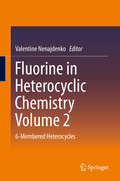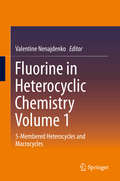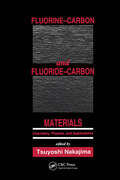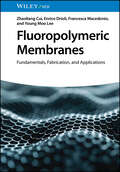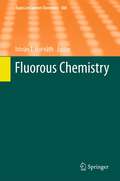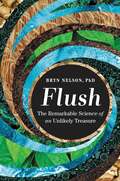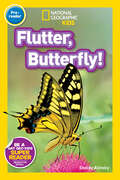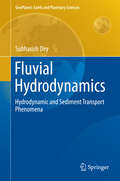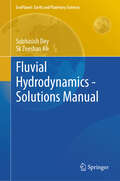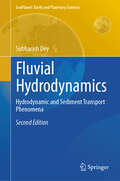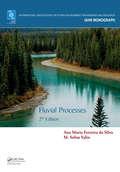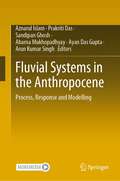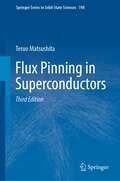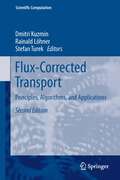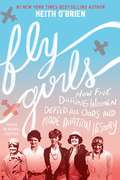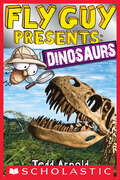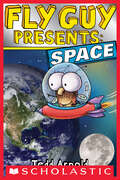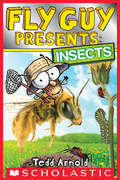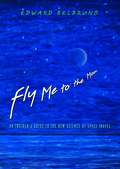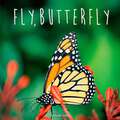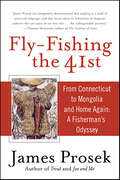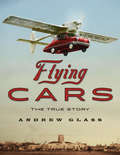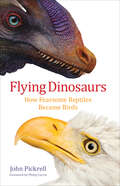- Table View
- List View
Fluorine in Heterocyclic Chemistry Volume 2
by Valentine NenajdenkoThis two-volume work combines comprehensive information on the chemistry of the fluorinated heterocycles. The material has been divided such that the first volume is dedicated to 5-membered fluorinated heterocycles and macrocycles, while the second volume combines data connected with the chemistry of fluorine containing 6-membered heterocycles. Both volumes will be of interest to synthetic organic chemists in general, and particularly for those colleagues working in the fields of heterocyclic-compound chemistry, materials chemistry, medicinal chemistry, and fluorine chemistry. All information is presented and classified clearly to be effective source for broad auditory of chemists. It will be interesting for scientists working in the field of inorganic and coordination chemistry. Fluorinated heterocycles are becoming increasingly important in many areas including the pharmaceutical industry, materials science and agriculture. The presence of fluorine can result in substantial functional changes in the biological as well as physicochemical properties of organic compounds. Incorporation of fluorine into drug molecules can greatly affect their physicochemical properties, such as bond strength, lipophilicity, bioavailability, conformation, electrostatic potential, dipole moment, pKa etc. as well as pharmacokinetic properties, such as tissue distribution, rate of metabolism and pharmacological properties, such as pharmacodynamics and toxicology.
Fluorine in Heterocyclic Chemistry Volume 1
by Valentine NenajdenkoThis two-volume work combines comprehensive information on the chemistry of the fluorinated heterocycles. The material has been divided such that the first volume is dedicated to 5-membered fluorinated heterocycles and macrocycles, while the second volume combines data connected with the chemistry of fluorine containing 6-membered heterocycles. Both volumes will be of interest to synthetic organic chemists in general, and particularly for those colleagues working in the fields of heterocyclic-compound chemistry, materials chemistry, medicinal chemistry, and fluorine chemistry. All information is presented and classified clearly to be effective source for broad auditory of chemists. It will be interesting for scientists working in the field of inorganic and coordination chemistry. Fluorinated heterocycles are becoming increasingly important in many areas including the pharmaceutical industry, materials science and agriculture. The presence of fluorine can result in substantial functional changes in the biological as well as physicochemical properties of organic compounds. Incorporation of fluorine into drug molecules can greatly affect their physicochemical properties, such as bond strength, lipophilicity, bioavailability, conformation, electrostatic potential, dipole moment, pKa etc. as well as pharmacokinetic properties, such as tissue distribution, rate of metabolism and pharmacological properties, such as pharmacodynamics and toxicology.
Fluorine-Carbon and Fluoride-Carbon Materials: Chemistry, Physics, and Applications
by Tsuyoshi Nakajima"This outstanding reference presents the latest scientific findings concerning the synthesis, structure, thermodynamics, and physical and chemical properties of fluorine- and fluoride-carbon compounds elucidating their practical applications in lithium batteries, superhydrophobic composites, and the electrolytic production of elemental fluorine."
Fluoropolymeric Membranes: Fundamentals, Fabrication, and Applications
by Enrico Drioli Young Moo Lee Zhaoliang Cui Francesca MacedonioEnables readers to gain a comprehensive understanding of fluoropolymeric membrane science and technology from a single resource Fluoropolymeric Membranes: Fundamentals, Fabrication, and Applications comprehensively and systematically covers the basic science and technology of fluoropolymeric membranes, which have high mechanical strength and excellent chemical stability and thus have been employed for the last several decades as materials for membrane separation processes in a variety of applications. Written by four highly qualified authors, Fluoropolymeric Membranes includes information on: Typical fluoropolymers like poly(vinylidene fluoride), poly(tetrafluoroethylene), and poly(ethylene chlorotrifluoroethylene) Structure and properties of fluoropolymeric membranes, and fabrication strategies of advanced fluoropolymeric membranes Fluoropolymeric membranes novel applications in chemical- and bio-separations, hybrid systems, energy, fuel cells, batteries, gas and air treatments, and more How fluoropolymeric membranes support common water treatment processes, such as ultrafiltration, microfiltration, MBR membrane processes, and more New membrane operations such as membrane distillation, membrane crystallization, membrane emulsification, and membrane contactors Providing complete coverage on the subject, Fluoropolymeric Membranes is an essential resource for polymer chemists, membrane scientists, process engineers, materials scientists, water chemists, environmental chemists, and chemists in industry.
Fluorous Chemistry
by István T. HorváthStructural, Physical, and Chemical Properties of Fluorous Compounds, by J.A. Gladysz Selective Fluoroalkylation of Organic Compounds by Tackling the "Negative Fluorine Effect", by W. Zhang, C. Ni and J. Hu Synthetic and Biological Applications of Fluorous Reagents as Phase Tags, by S. Fustero, J. L. Aceña and S. Catalán Chemical Applications of Fluorous Reagents and Scavengers, by Marvin S. Yu Fluorous Methods for the Synthesis of Peptides and Oligonucleotides, by B. Miriyala Fluorous Organic Hybrid Solvents for Non-Fluorous Organic Synthesis, by I. Ryu Fluorous Catalysis: From the Origin to Recent Advances, by J.-M. Vincent Fluorous Organocatalysis, by W. Zhang Thiourea Based Fluorous Organocatalyst, by C. Cai Fluoroponytailed Crown Ethers and Quaternary Ammonium Salts as Solid-Liquid Phase Transfer Catalysts in Organic Synthesis, by G. Pozzi and R. H. Fish Fluorous Hydrogenation, by X. Zhao, D. He, L. T. Mika and I. T. Horváth Fluorous Hydrosilylation, by M. Carreira and M. Contel Fluorous Hydroformylation, by X. Zhao, D. He, L.T. Mika and I. Horvath Incorporation of Fluorous Glycosides to Cell Membrane and Saccharide Chain Elongation by Cellular Enzymes, by K. Hatanaka Teflon AF Materials, by H. Zhang and S. G. Weber Ecotoxicology of Organofluorous Compounds, by M. B. Murphy, E. I. H. Loi, K. Y. Kwok and P. K. S. Lam Biology of Fluoro-Organic Compounds, by X.-J. Zhang, T.-B. Lai and R. Y.-C. Kong
Flush: The Remarkable Science of an Unlikely Treasure
by Bryn NelsonFor readers of Giulia Enders&’ Gut and Bill Bryson&’s The Body, a surprising, witty and sparkling exploration of the teeming microbiome of possibility in human feces from microbiologist and science journalist Bryn Nelson.The future is sh*t: the literal kind. For most of human history we&’ve been, well, disinclined to take a closer look at our body&’s natural product—the complex antihero of this story—save for gleaning some prophecy of our own health. But if we were to take more than a passing look at our poop, we would spy a veritable cornucopia of possibilities. We would see potent medicine, sustainable power, and natural fertilizer to restore the world&’s depleted lands. We would spy a time capsule of evidence for understanding past lives and murderous ends. We would glimpse effective ways of measuring and improving human health from the cradle to the grave, early warnings of community outbreaks like Covid-19, and new means of identifying environmental harm—and then reversing it.Flush is both an urgent exploration of the world&’s single most squandered natural resource, and a cri de coeur (or cri de colon?) for the vast, hidden value in our &“waste.&” Award-winning journalist and microbiologist Bryn Nelson, PhD, leads readers through the colon and beyond with infectious enthusiasm, helping to usher in a necessary mental shift that could restore our balance with the rest of the planet and save us from ourselves. Unlocking poop&’s enormous potential will require us to overcome our shame and disgust and embrace our role as the producers and architects of a more circular economy in which lowly byproducts become our species&’ salvation. Locked within you is a medicine cabinet, a biogas pipeline, a glass of drinking water, a mound of fuel briquettes; it&’s time to open the doors (carefully!). A dose of medicine, a glass of water, a gallon of rocket fuel, an acre of soil: sometimes hope arrives in surprising packages.
Flushed with Pride: The Story of Thomas Crapper
by Wallace RayburnFlushed with Pride celebrates the life and times of Thomas Crapper, the man who revolutionised the nation's water closets and plumber By Appointment to Edward VII. First published 20 years ago, this fascinating book achieved cult status on both sides of the Atlantic and is now reissued for the delectation of loo readers everywhere.
Flute's Journey
by Lynne CherryA young wood thrush makes his first migration from his nesting ground in a forest preserve in Maryland to his winter home in Costa Rica and back again.
Flutter, Butterfly! (National Geographic Kids Readers)
by Shelby AlinskyThis colorful pre-reader uses simple vocabulary and fun pictures to capture the interest and help develop the skills of beginning readers. The fun, informative facts about one of kids' favorite creatures make this new reading experience a treat.
Fluvial Hydrodynamics
by Subhasish DeyThe state-of-the-art in fluvial hydrodynamics can be examined only through a careful exploration of the theoretical development and applied engineering technology. The book is primarily focused, since most up-to-date research findings in the field are presented, on the research aspects that involve a comprehensive knowledge of sediment dynamics in turbulent flows. It begins with the fundamentals of hydrodynamics and particle motion followed by turbulence characteristics related to sediment motion. Then, the sediment dynamics is analysed from a classical perspective by applying the mean bed shear approach and additionally incorporating a statistical description for the role of turbulence. The work finally examines the local scour problems at hydraulic structures and scale models. It is intended to design as a course textbook in graduate / research level and a guide for the field engineers as well, keeping up with modern technological developments. Therefore, as a simple prerequisite, the background of the readers should have a basic knowledge in hydraulics in undergraduate level and an understanding of fundamentals of calculus.
Fluvial Hydrodynamics - Solutions Manual (GeoPlanet: Earth and Planetary Sciences)
by Subhasish Dey Sk Zeeshan AliThe book provides the solutions to the unsolved problems given in the book titled Fluvial Hydrodynamics: Hydrodynamic and Sediment Transport Phenomena. The manual includes the solutions to the problems on Chapters 1 to 11, including the properties of fluid and sediment, hydrodynamic principles, turbulence in open-channel flows, sediment threshold, bedload transport, suspended-load transport, total-load transport, bedforms, river processes, scour, and dimensional analysis and similitude. It, therefore, serves as a guide for graduate students, researchers, and field engineers to solve the problems in fluvial hydrodynamics. As a prerequisite, the background of the readers should have a knowledge in fluvial hydrodynamics described in the said book and an understanding of fundamentals of calculus.
Fluvial Hydrodynamics: Hydrodynamic and Sediment Transport Phenomena (GeoPlanet: Earth and Planetary Sciences)
by Subhasish DeyThis revised second edition of the book presents an improvement of the original version in terms of recent research, corrections, and outline. The state of the art in fluvial hydrodynamics can be examined only through a careful exploration of the theoretical development and applied engineering technology. This second, updated edition focuses, since most up-to-date research findings in the field are presented, on the research aspects that involve a comprehensive knowledge of sediment dynamics in turbulent flows. It begins with the fundamentals of hydrodynamics and particle motion followed by turbulence characteristics related to sediment motion. Sediment dynamics are described from a classical perspective by applying the mean bed shear approach and additionally incorporating a statistical description for the role of turbulence. It is intended to design as a course textbook in graduate / research level and a guide for the field engineers as well, keeping up with modern technological developments. One of the most important additions is that at the end of each chapter, varieties of problems were given. Therefore, as a simple prerequisite, the background of the readers should have a basic knowledge in hydraulics in undergraduate level and an understanding of fundamentals of calculus.
Fluvial Processes: 2nd Edition (IAHR Monographs)
by Ana Maria da Silva M. Selim YalinA stream flowing in alluvium deforms its bed surface, forming ripples, dunes, bars, etc., and, in many instances, it deforms its channel entirely, thereby creating meandering or braiding patterns. It could be said that, in general, an alluvial stream and its deformable boundary undergo a variety of fluvial processes leading to the emergence of a multitude of alluvial forms. This book concerns the physics and analytical treatment of various fluvial processes and the associated alluvial bed and plan forms listed above. Following an introductory chapter on the basics of turbulent flow and sediment transport, the book covers the origin, geometric characteristics and effects of bed forms, from small- to meso-scale (ripples, dunes, alternate and multiple bars); the initiation, geometry and mechanics of meandering streams; the computation of flow, bed deformation and the planimetric evolution of meandering streams; and braiding and delta formation. The book also covers the regime concept, the time-development of a stream towards its regime state, and the formulation of stable, or equilibrium, morphology. The book distinguishes itself by its comprehensive analysis and discussion of key processes involved in large-scale river morphodynamics. The book was written primarily for researchers and graduate students of hydraulic engineering, water resources and related branches of earth sciences, but it will also prove useful for river engineers and managers.
Fluvial Systems in the Anthropocene: Process, Response and Modelling
by Sandipan Ghosh Aznarul Islam Arun Kumar Singh Prakriti Das Abarna Mukhopadhyay Ayan Das GuptaThis book addresses the various factors affecting fluvial systems, the processes governing them, system responses arising from human-nature interventions, and geospatial and geo-ecological modeling to understand system behaviour better and restore degraded ecosystems around the globe. Thanks to their hydrological and agro-ecological advantages, humans have settled along riverbanks since the dawn of civilization. Thus, the ancient "ecumene" (settlements) were located near major rivers worldwide. This legacy of river-based civilizations continues to this day in many forms. However, in the course of the 'Anthropocene' era, countless fluvial systems have been altered by human interventions in the form of large-scale dams and barrages, changes in land use and land cover, road-stream crossings, mining of sand and gravel, mushrooming of brickfield, expansion of modern agriculture, industrial growth, and urbanization. Thus, the present-day development pattern threatens fluvial systems, especially riverine morphology and ecosystems. In brief, human-induced morphological changes, water pollution, eutrophication, and related damages to aquatic organisms are the major threats to fluvial systems. Thus, maintaining the 'environmental flow' of the world's major rivers to preserve the proper functioning of riverine ecosystems and promote sustainable development is a global challenge.
Flux Pinning in Superconductors (Springer Series in Solid-State Sciences #198)
by Teruo MatsushitaThis book covers the flux pinning mechanisms and properties and the electromagnetic phenomena caused by the flux pinning common for metallic, high-Tc and MgB2 superconductors. The condensation energy interaction known for normal precipitates or grain boundaries and the kinetic energy interaction proposed for artificial Nb pins in Nb-Ti, etc., are introduced for the pinning mechanism. Summation theories to derive the critical current density are discussed in detail. Irreversible magnetization and AC loss caused by the flux pinning are also discussed. The loss originally stems from the ohmic dissipation of normal electrons in the normal core driven by the electric field induced by the flux motion.The influence of the flux pinning on the vortex phase diagram in high Tc superconductors is discussed, and the dependencies of the irreversibility field are also described on other quantities such as anisotropy of superconductor, specimen size and electric field strength. Recent developments of critical current properties in various high-Tc superconductors and MgB2 are introduced.The 3rd edition has been thoroughly updated, with a new chapter on critical state model. The mechanism of irreversible properties is discussed in detail. The author provides calculations of pinning loss by the equation of motion of flux lines in the pinning potential and hysteresis loss. The readers will learn why the resultant loss is of hysteresis type in spite of such mechanism. This book aims for graduate students and researchers studying superconductivity as well as engineers working in electric utility industry.
Flux-Corrected Transport
by Dmitri Kuzmin Rainald Löhner Stefan TurekAddressing students and researchers as well as Computational Fluid Dynamics practitioners, this book is the most comprehensive review of high-resolution schemes based on the principle of Flux-Corrected Transport (FCT). The foreword by J.P. Boris and historical note by D.L. Book describe the development of the classical FCT methodology for convection-dominated transport problems, while the design philosophy behind modern FCT schemes is explained by S.T. Zalesak. The subsequent chapters present various improvements and generalizations proposed over the past three decades. In this new edition, recent results are integrated into existing chapters in order to describe significant advances since the publication of the first edition. Also, 3 new chapters were added in order to cover the following topics: algebraic flux correction for finite elements, iterative and linearized FCT schemes, TVD-like flux limiters, acceleration of explicit and implicit solvers, mesh adaptation, failsafe limiting for systems of conservation laws, flux-corrected interpolation (remapping), positivity preservation in RANS turbulence models, and the use of FCT as an implicit subgrid scale model for large eddy simulations.
Fly Girls Young Readers’ Edition: How Five Daring Women Defied All Odds and Made Aviation History
by Keith O'BrienFrom NPR correspondent Keith O’ Brien comes this thrilling Young Readers' edition of the untold story about pioneering women, including Amelia Earhart, who fought to compete against men in the high-stakes national air races of the 1920s and 1930s—and won. In the years between World War I and World War II, airplane racing was one of the most popular sports in America. Thousands of fans flocked to multiday events, and the pilots who competed in these races were hailed as heroes. Well, the male pilots were hailed. Women who flew planes were often ridiculed by the press, and initially they weren’t invited to race. Yet a group of women were determined to take to the sky—no matter what. With guts and grit, they overcame incredible odds both on the ground and in the air to pursue their dreams of flying and racing planes.Fly Girls follows the stories of five remarkable women: Florence Klingensmith, a high‑school dropout from North Dakota; Ruth Elder, an Alabama housewife; Amelia Earhart, the most famous, but not necessarily the most skilled; Ruth Nichols, a daughter of Wall Street wealth who longed to live a life of her own; and Louise Thaden, who got her start selling coal in Wichita. Together, they fought for the chance to race against the men—and in 1936 one of them would triumph in the toughest race of all. Complete with photographs and a glossary, Fly Girls celebrates a little-known slice of history wherein tenacious, trail-blazing women braved all obstacles to achieve greatness.
Fly Guy Presents: Dinosaurios/ Dinosaurs (Scholastic Reader, Level 2)
by Tedd ArnoldLearn all about dinosaurs with Fly Guy and Buzz!Fly Guy and Buzz are ready for their next field trip! And in FLY GUY PRESENTS: DINOSAURS they visit a natural history museum to learn all about dinosaurs. With straightforward text, humorous asides, and kid-friendly full-bleed photographs throughout, young readers will learn lots of fun facts about these prehistoric creatures. Award-winning author/illustrator Tedd Arnold really brings nonfiction to life in this fun nonfiction reader!
Fly Guy Presents: Four Books In One (Scholastic Reader, Level 2)
by Tedd ArnoldFly Guy and Buzz are back with another great nonfiction book!Award-winning author/illustrator Tedd Arnold brings nonfiction to life in this engaging nonfiction reader! During a visit to a space museum, Fly Guy and Buzz learn all about planets, space crafts, space suits, and even dirty snowballs (i.e. comets!)! With straightforward fun facts, humorous illustrations of Fly Guy and Buzz, and vivid photographs throughout, this book is sure to be a hit with budding astronauts everywhere!*HOLOGRAPHIC FOIL ON THE COVER!*
Fly Guy Presents: Insects (Scholastic Reader, Level 2 #2)
by Tedd ArnoldLearn all about insects with Fly Guy and Buzz!Fly Guy and Buzz are ready for their next field trip! And in FLY GUY PRESENTS: INSECTS they go outside to learn all about other insects like Fly Guy! With straightforward text, humorous asides, and kid-friendly full-bleed photographs throughout, young readers will learn lots of fun facts about all sorts of bugs. Award-winning author/illustrator Tedd Arnold really brings nonfiction to life!
Fly Me to the Moon: An Insider's Guide to the New Science of Space Travel
by Edward BelbrunoWhen a leaf falls on a windy day, it drifts and tumbles, tossed every which way on the breeze. This is chaos in action. In Fly Me to the Moon, Edward Belbruno shows how to harness the same principle for low-fuel space travel--or, as he puts it, "surfing the gravitational field." Belbruno devised one of the most exciting concepts now being used in space flight, that of swinging through the cosmos on the subtle fluctuations of the planets' gravitational pulls. His idea was met with skepticism until 1991, when he used it to get a stray Japanese satellite back on course to the Moon. The successful rescue represented the first application of chaos to space travel and ushered in an emerging new field. Part memoir, part scientific adventure story, Fly Me to the Moon gives a gripping insider's account of that mission and of Belbruno's personal struggles with the science establishment. Along the way, Belbruno introduces readers to recent breathtaking advances in American space exploration. He discusses ways to capture and redirect asteroids; presents new research on the origin of the Moon; weighs in on discoveries like 2003 UB313 (now named Eris), a dwarf planet detected in the far outer reaches of our solar system--and much more. Grounded in Belbruno's own rigorous theoretical research but written for a general audience, Fly Me to the Moon is for anybody who has ever felt moved by the spirit of discovery.
Fly, Butterfly (Penguin Core Concepts)
by Bonnie BaderExposing children to a diverse range of literary and informational texts, the Core Concepts program helps develop important literacy and cognitive skills necessary to meet many of the Common Core State Standards. Did you know that every year hundreds of thousands of monarch butterflies migrate 2,500 miles to Mexico for the winter? It takes four generations of butterflies to make the trip, and only the fourth generation lives longer than three weeks. Follow a beautiful butterfly as she makes her journey down to Mexico!Fly, Butterfly covers the concepts Animals and Seasons.
Fly-Fishing the 41st: From Connecticut to Mongolia and Home Again—A Fisherman's Oddesy
by James Prosek“James Prosek has eloquently demonstrated that angling is a kind of universal language. . . . he has taken us on an unforgettable journey.” — Thomas McGuane, author of The Cadence of Grass and The Longest Silence: A Life in FishingThe New York Times has called James Prosek "the Audubon of the fishing world," and in Fly-Fishing the 41st, he uses his talent for descriptive writing to illuminate an astonishing adventure. Beginning in his hometown of Easton, Connecticut, Prosek circumnavigates the globe along the 41st parallel, traveling through Spain, Greece, Turkey, Armenia, Kyrgyzstan, China, and Japan. Along the way he shares some of the best fishing in the world with a host of wonderfully eccentric and memorable characters.
Flying Cars: The True Story
by Andrew GlassStories of inventors who have aimed for the sky: &“Start your engines and get ready to take off for an amazing read&” (Kirkus Reviews, starred review). Humans have always wanted to fly—and as soon as there were planes and cars, many people saw a combination of the two as the next step for personal transportation. Visionary engineers and inventors did their best to make the flying car a reality, not just an elusive dream. This book is a breezy account of hybrid vehicles and their creators, and of the intense drive that kept bringing inventors back to the drawing board despite repeated failures and the dictates of common sense. Illustrated with archival photos, this entertaining survey tells the stories of dreamers from Robert Fulton to Henry Ford to Buckminster Fuller, taking readers as far back as Icarus and forward into the present day—with a look toward the possibilities of the future as well. &“Readers learn about many intriguing airplane-car hybrids, such as the Airphibian, invented by Robert Fulton, who flew his vehicle at 110 miles per hour, landed it, single-handedly converted it into a car in under five minutes, then &‘drove the convertible proudly into Manhattan at a breezy 55 miles per hour.&’ These stories of invention are undeniably appealing. . . . Fascinating.&” —School Library Journal Includes illustrations, source notes, bibliography, and an index
Flying Dinosaurs: How Fearsome Reptiles Became Birds
by John PickrellThe discovery of stunning, feathered dinosaur fossils coming out of China since 2006 suggest that these creatures were much more bird-like than paleontologists previously imagined. Further evidence—bones, genetics, eggs, behavior, and more—has shown a seamless transition from fleet-footed carnivores to the ancestors of modern birds.Mixing colorful portraits with news on the latest fossil findings and interviews with leading paleontologists in the United States, China, Europe, and Australia, John Pickrell explains and details dinosaurs' development of flight. This special capacity introduced a whole new range of abilities for the animals and helped them survive a mass extinction, when thousands of other dinosaur species that once populated the Earth did not. Pickrell also turns his journalistic eye toward the stories behind the latest discoveries, investigating the role of the Chinese black market in trading fossils, the controversies among various dinosaur hunters, the interference of national governments intent on protecting scientific information, and the race to publish findings first that make this research such a dynamic area of science.
